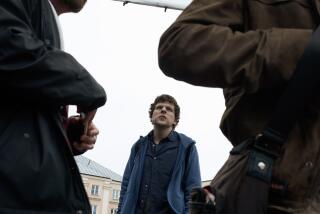Spielberg’s Still in Never-Never Land
- Share via
Believing Kenneth Turan (“Restraint From the Master of Razzmatazz,” Calendar, Dec. 15) and all the other critics who have waxed poetic about Steven Spielberg’s latest blockbuster, I attended “Schindler’s List” with an open mind hoping that Spielberg had somehow managed to make a film divorced from the fairy-tale perceptions that had been emblematic of his earlier work. Once the three-hour-plus epic concluded it was obvious that although his style and subject matter may have matured, his thematics remain in never-never land. Contrary to the sobs of the audience and the praise of film boards across the country, it is quite clear that the emperor is still unclothed, and his magnum opus is more about a single Nazi than it is about 6 million Jews.
Unlike his earlier portrayal of the Nazis as bumbling, cartoon characters in supporting roles in the “Indiana Jones” trilogy and “1941,” they are now at the forefront of the drama. Instead of Jew vs. Nazi, it is good Nazi vs. bad Nazi, Schindler in opposition to his double, Amon Goeth. The Jews are relegated to supporting roles, unable to act as protagonists in their own historical drama. The only Jew approaching a man of action is the Ben Kingsley character, yet even he is portrayed as a stuffy, cold accountant.
Like Richard Attenborough’s “Cry Freedom,” where a film purportedly about the oppression of black South Africans has its only black protagonist, Steve Biko, die halfway through the story with the remainder centering on the plight of Donald Woods, a white South African, “Schindler’s List” manages to marginalize the people who should be at the narrative’s center. The Jews become vehicles to promote their Gentile savior. Where Leni Riefenstahl blatantly portrays Hitler as a God by having him descend from the clouds at the opening of “Triumph of the Will,” at least Spielberg is somewhat more subtle in his depiction of Schindler. As if Liam Neeson (at a height of 6-foot-4) doesn’t already tower over the other characters, Spielberg finds it necessary to shoot him continually from the knees up, in order to emphasize his deification.
A group of women who were supposed to go to Schindler’s camp are instead herded into the gas chambers at Auschwitz. The camera follows as the suspense is elongated with close-ups of horrified faces and threatening shower heads. But to my horror the gas chambers had been “Spielbergized” and water poured down over the women. What fodder to historical revisionists who insist that the Holocaust never happened. Spielberg has reduced the gas chambers to a dramatic device, so that Schindler again can single-handedly save these women. True, this scene is based on events recalled by survivors, but there is not another scene in the film that shows the gas chambers. From this film, how are we to know that gas ever came down?
At the end of the movie, the survivors march to the strains of a bathetic score to again honor their savior. It is a happy ending because they have survived. Unlike the facile optimism of “Schindler’s List,” Elie Wiesel’s novel “Night” reveals the devastation of the Holocaust. At the end of the novel the protagonist looks in the mirror and sees a corpse staring back. At the end of “Schindler’s List” the survivors, who walk with the actors that portray them in the film, look down and see a memorial to a superstar.
Critics who have reservations about the film still argue that it is “important,” that it “gets people talking.” This is true; people are talking about the Holocaust, but what Holocaust are they talking about? Spielberg has brought his “magic” to the Holocaust and has made the unthinkable palatable.
More to Read
Only good movies
Get the Indie Focus newsletter, Mark Olsen's weekly guide to the world of cinema.
You may occasionally receive promotional content from the Los Angeles Times.










